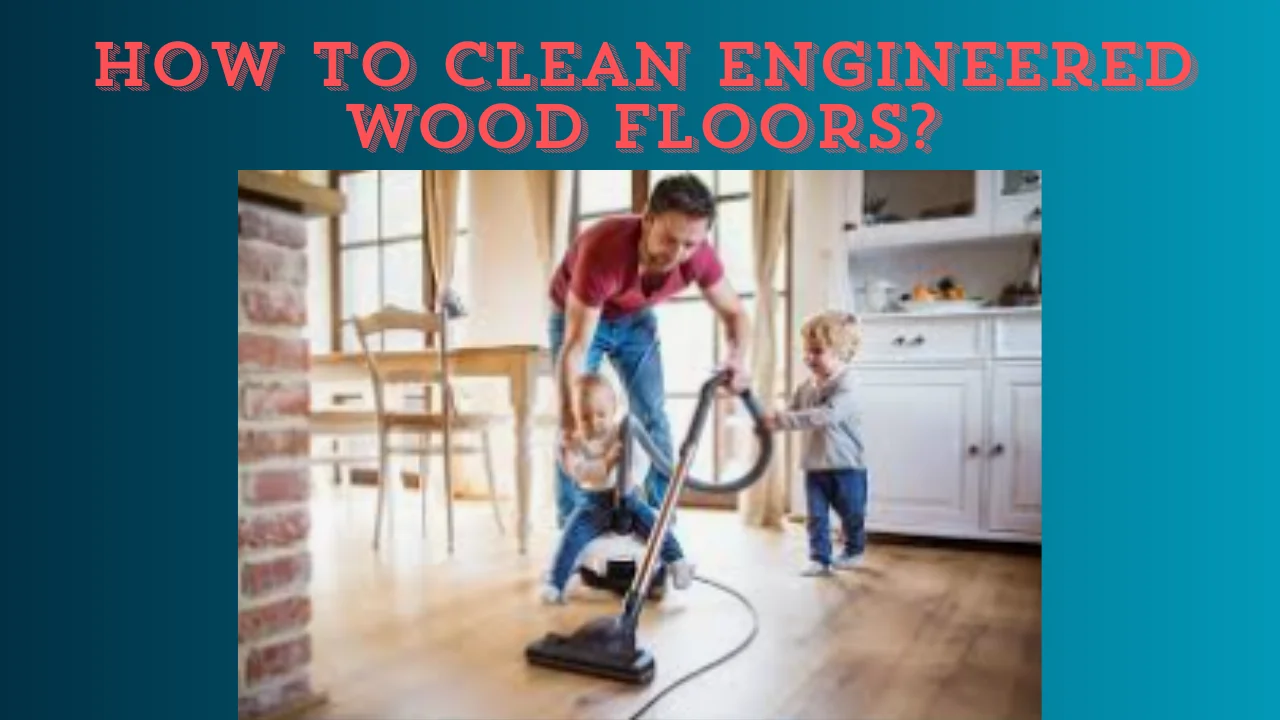The beauty and natural warmth of wood are brought together with the stability and longevity of layered construction in engineered wood floors. To keep these floors looking brand new for years to come, however, special attention is required during maintenance. The purpose of this guide is to teach homeowners how to clean engineered wood floors? in a way that won’t harm the floors while still getting the job done.
Understanding Engineered Wood Floors
Layers of plywood or another type of wood are adhered to the top of engineered wood flooring, which consists of a hardwood veneer. Dimensional stability provided by this structure makes it resistant to warping and bowing, two issues that can arise with solid hardwood floors. To keep their look and durability, engineered wood floors require specific cleaning procedures and products due to their composition and finish.
Daily Care
Regular Dusting and Sweeping
To keep the floor’s surface from becoming scratched, it’s important to sweep and dust it frequently. To delicately sweep the floor, use a broom with soft bristles or a mop made of microfiber. This routine maintenance keeps the surface free of scratches caused by dirt and grit.
Prompt Spill Clean-Up
In order to avoid water damage or stains, spills should be cleaned up right away. For delicate blotting of spills, use a dry, soft cloth. You should not let water sit on the surface because it can penetrate and cause discoloration or warping.
Strategic Rug Placement
Rugs or mats placed in entryways and other high-traffic areas can help keep dirt and debris off wood floors. To keep the wood surface from becoming stained, look for rugs that have a natural rubber backing.
Furniture Pads Use
Put felt or rubber bumpers under furniture legs to protect them from damage. To keep these pads protecting the floor from scratches and scuffs, check on them often and replace them if necessary.
Controlled Indoor Climate
The expansion and contraction of wood can cause cracks and gaps if the indoor climate is not stable with moderate humidity levels. Stabilizing the environment can be achieved by using a humidifier or dehumidifier as required.
Weekly Cleaning Techniques
Gentle Vacuuming
To clean the floor and spaces between the boards, use a vacuum cleaner equipped with a soft brush attachment. If you don’t want the beater bar to scratch the floor, you should turn the vacuum to “hard floor” mode.
Appropriate Mopping
Use a damp mop and an acid-free floor cleaner made specifically for engineered wood floors to wipe down the floor. To prevent the wood from being damaged by excessive moisture, make sure the mop is well-wrung.
Spot Cleaning
To remove tough stains like lipstick, oil, paint, or markers, follow the manufacturer’s instructions for the flooring’s recommended cleaning solution. Gently rub the stain after applying the cleanser to a fresh cloth. If you don’t want to damage the wood or remove the finish, don’t use harsh chemicals.
Periodic Deep Cleaning
Think about doing a deeper cleaning every few months. To clean your wood floors, follow the manufacturer’s instructions. Utilize a microfiber mop to evenly distribute the cleaner on the floor, and then, afterward, use a dry mop to remove any surplus moisture.
Preventative Measures
Avoiding Harsh Cleaners
To protect the finish and the wood from harm, avoid using abrasive cleaning tools and strong chemicals. Stay away from steel wool, ammonia-based cleaning products, and wax-based items.
Proper Shoe Etiquette
To protect the floor from dirt and tiny stones, ask visitors and family to take off their shoes before entering the house.
Sunlight Protection
Sunlight can fade and discolor wood over time, so it’s best to block it as much as possible with curtains or blinds. This is especially crucial for flooring that is close to big glass doors or windows.
Regular Inspections
Keep an eye out for damage or wear on the floor. You can extend the life of your engineered wood floors by catching small problems early on before they become big ones.
Cleaning Techniques for Engineered Wood Floors
Choosing the Right Cleaning Products
The longevity of engineered wood floors depends on your careful product selection when cleaning them. For best results, use a pH-neutral, chemical-free cleaner made especially for engineered wood. Protect the wood layers and maintain the finish with these expert products.
Using Microfiber Mops
When cleaning engineered wood floors, a microfiber mop is your best bet. To avoid damaging the floor’s surface, use a microfiber mop. These mops are both soft and effective, capturing dirt and particles in their fibers. Plus, they soak up a lot of water, so there’s less of it left on the floor.
Role of Steam Cleaners
Popular as steam cleaners may be, they can damage engineered wood floors if not handled with care. Cupping and warping can occur if the glue between the wood layers is damaged by using too much steam or heat. When using a steam mop, be sure to use the lowest setting and avoid leaving the steam on the floor for too long.
Cleaning Under Furniture and Appliances
Keep the space under your furniture and appliances clean on a regular basis, since that’s a common hiding place for dust and filth. Whenever you have a deep cleaning session, this is something you can accomplish. To avoid damaging the floor, use a vacuum with a flat attachment to get into those hard-to-reach places.
Remedying Common Problems with Engineered Wood Floors
Removing Stains and Spots
When dealing with stains, it’s best to act immediately. Use a moist cloth and a drop of a pH-neutral cleanser to remove typical stains such as food, liquids, or mud. You might need to use a wood floor cleaner designed specifically for stubborn stains like ink or wine.
Repairing Scratches
In most cases, a touch-up kit made especially for engineered wood floors or wood putty that matches the floor’s color will be sufficient to repair small scratches. If the top veneer layer is severely damaged or if the scratches are deeper, it may be necessary to have the veneer professionally refinished.
Dealing with Water Damage
Eliminating any remaining moisture should be your top priority when dealing with water damage. Blot the area with a dry, absorbent cloth; to hasten drying, use a dehumidifier or fan. Talk to an expert about your options for fixing or replacing the flooring if it buckles or warps.
Maintaining Floor Finish
The finish of engineered wood floors, particularly in heavily walked areas, can fade with time. Use an engineered flooring-approved floor refresher or revitalizer to preserve the floor’s sheen and wood’s natural beauty. You won’t even need to sand to use these products to fix small dings and bring back that shine.
FAQs
Q: Can I use vinegar to clean my engineered wood floors?
It is best to avoid vinegar as it can degrade the protective finish over time. Instead, use a pH-neutral floor cleaner designed for engineered wood.
Q: How often should I clean my engineered wood floors?
Sweep or vacuum daily, and mop weekly or as needed to remove dirt and grime. Deep clean every few months, depending on traffic and wear.
Q: Is it safe to use a wax on engineered wood floors?
Avoid using wax on engineered wood floors as it can create a buildup and dull the surface. Stick to cleaners and finishes specifically recommended for engineered wood.
Q: Can furniture sliders be used on engineered wood floors?
Yes, furniture sliders are recommended for moving heavy furniture across engineered wood floors to prevent scratches and damage.
Q: How can I prevent my engineered wood floors from fading?
Protect floors from direct sunlight with curtains, blinds, or UV-protective window films to prevent fading and discoloration over time.
Conclusion
Maintaining your engineered wood floors on a regular basis will prolong their life and keep them looking beautiful. If you’re wondering how to clean engineered wood floors? it’s quite simple. Start by regularly sweeping or vacuuming to remove dirt and debris. Then, use a damp mop with a mild cleaning solution specifically formulated for engineered wood floors. Avoid excess water and harsh chemicals, as these can damage the wood. Always follow the manufacturer’s recommendations for cleaning and care to ensure the longevity of your floors.

Shannon Reyes is a seasoned writer with a knack for crafting engaging blogs on a variety of service industries, including plumbing, cleansing, moving, pest control, and roofing. With a keen eye for detail and a passion for helping readers navigate complex topics, Shannon brings her expertise to life through informative and accessible content.










